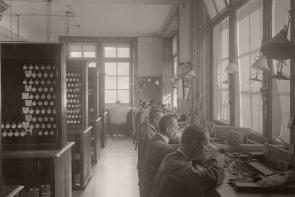It has always mystified me why so many Swiss watchmaking brands distance themselves from their industrial side. I mean, I get that people love this romanticised idea of an old Swiss guy making individual watches by hand in an Alpine chalet, but let’s face it — if that was really the case, watches would cost at least a hundred times more than they already do and no one would want to buy them. The industrialisation of Swiss watchmaking is a fascinating story; the industrial watchmaking process itself is a magnificent thing to behold. The narrative of “hand-made” should complement and not eclipse the narrative of industrialisation, which is a story of ingenuity and endeavour. Besides, it wasn’t easy for the Swiss watch industry to get to where it is today. We would be doing an immense disservice to the entire watch world, and dishonouring its history, if we persist in this skewed depiction of a fully artisanal approach to watchmaking.
You should know that before 1870, the landscape of Swiss watchmaking could be characterised as a loose network of discrete specialist entities. There were ébauche-makers, individual casemakers, dialmakers, craftsmen who worked exclusively on hands, artisans who only focused on finishing. You had établisseurs, who performed the final assembly of movements, or cabinets, which were workshops employing people (known as cabinotiers) who practiced watchmaking and its related crafts. Tradesmen who shared a particular skill were organised into guilds for economic advancement and protection, but that was pretty much the extent of integrated watchmaking businesses or institutions.
That’s not to say that larger organisations didn’t exist. There were ébauche factories, such as Japy Frères in France and Fabrique d’Horlogerie de Fontainemelon (one of the foundation stones of modern movement colossus ETA). Just across the Swiss border in Ferney, there was the short-lived factory-commune established by Voltaire, but these were the exception rather than the norm. Even as the Industrial Revolution permanently changed the economic and social terrain of Europe, Swiss watchmaking remained almost exactly as it always had been, with strong guilds and entrenched systems resisting the tide of mechanisation.
In the last 30 years of the 19th century, two events took place that finally broke through the conservatism of the Swiss watch world and sparked the engine of reform. First, there was the 1876 Centennial International Exhibition in Philadelphia. It was a stupendous display of the industrial might of the United States. The Swiss delegation were deeply shaken by the ability of American watch companies to outperform their Helvetian counterparts. The Americans left their competitors in the dust when it came to producing watches in higher numbers, more quickly, more cheaply, and — the hardest for the Swiss to swallow — with better timekeeping performance.
The antipathy that Swiss watchmakers had previously shown towards industrialisation and mechanisation quickly evaporated in the face of this existential threat. The Société Intercantonale des Industries du Jura (which evolved over the years to become today’s Federation of the Swiss Watch Industry) an organisation established to safeguard the interests of Swiss watchmaking, took the lead in reform efforts.
The second event was the 1893 World’s Columbian Exposition, otherwise known as the Chicago World’s Fair. Determined not to be shown up by the other countries, a re-energised Swiss contingent arrived, guns blazing. They brought only the very best Swiss-made timekeeping instruments with them, armoured in the conviction that their success was a matter of Swiss pride. At the fair, the world-leading reputation of Swiss watchmaking was reestablished. A secondary effect was that their new industrialist directives were fully vindicated, wiping out the objections of any last holdouts in Terra Helvetia.
In other words, the end of the 19th century is when the Swiss watch industry first started behaving like an industry.
One of the key personalities involved in this drastic shift was Jacques David, the technical director of Longines, who visited the Philadelphia World’s Fair in 1876. Upon his return, he wrote a 108-page report on his findings. This included his observations of American watch factories, their production processes, quality control systems and supply-chain practices. He concluded with the recommendation that Swiss watchmakers should rapidly modernise in order to remain relevant on the international stage. As a member of the Société Intercantonale des Industries des Jura, Jacques David was able to influence a great number of leading minds with his report, and Longines was one of the first companies to adopt a fully modern, industrialised approach.

This story doesn’t get told enough, but every now and again I like to bring it up during History class at WorldTempus College. I’m afraid there will be a test, but I assure you the questions aren’t hard, and the prize is well worth the 10 minutes of reading you need to do. And even if you don’t get top marks, knowledge is its own reward.





